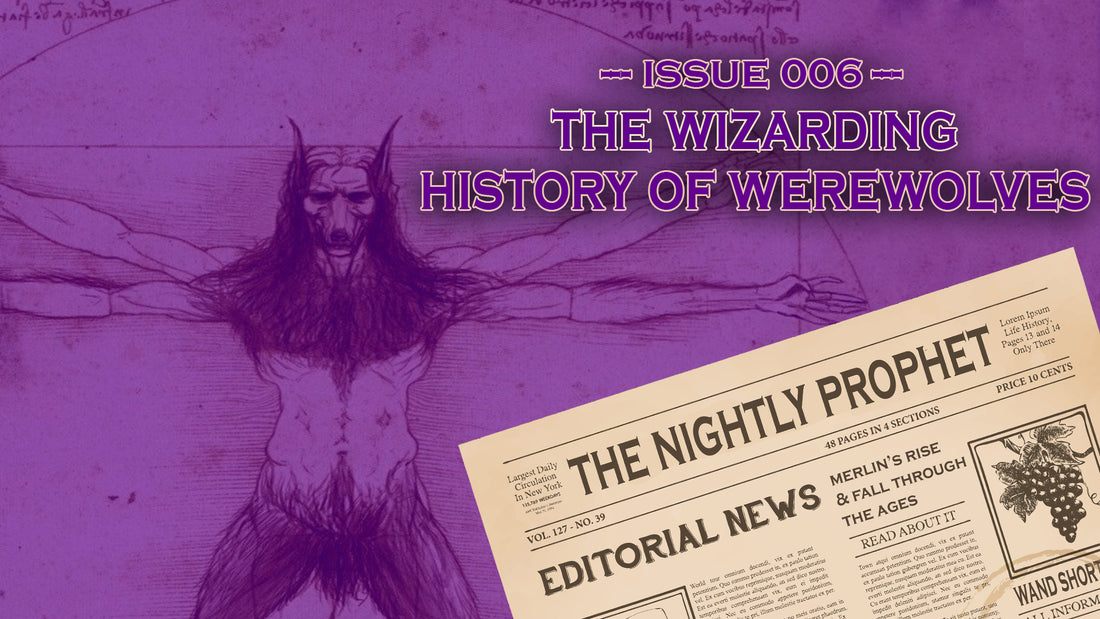In the enchanting world of wizardry, where magic weaves its spellbinding tapestry, few creatures evoke as much fascination and intrigue as werewolves. Exploring the labyrinthine history, enigmatic origins, and extraordinary characteristics of these shape-shifting beings, this scholarly investigation offers an unparalleled glimpse into the captivating realm of lycanthropy. Join us on an exhilarating journey through time and myth as we unravel the secrets surrounding werewolves, from their ancient origins to their portrayal in the rich tapestry of wizarding literature. The roots of lycanthropy can be traced back to the annals of ancient civilizations, where tales of humans transforming into wolves permeated the realms of myth and legend. From the ancient Greeks and their riveting accounts of the fearsome Lycaon to the Norse legends of the wolf warrior Ulfhednar, these ancient stories wove intricate narratives around the concept of shape-shifting individuals endowed with the power to assume the form of wolves. Further afield, Egyptian mythology chronicled the sacred bond between man and jackal, offering an intriguing glimpse into the complex web of animal-human transformation.

Lycanthropy in Historical Context:
Delving deeper into the historical context of lycanthropy reveals a rich tapestry of intriguing accounts and societal responses. Throughout the medieval period, documented cases of lycanthropy emerged, capturing the attention of both the fearful and the curious. Inquisitors and scholars sought to understand and explain the perplexing transformations experienced by individuals afflicted with the lycanthrope condition.
The Werewolf Trials, reminiscent of the infamous witch trials, swept through Europe during the 16th and 17th centuries, marking a dark chapter in the history of lycanthropy. Accusations of "werewolfism" were often intertwined with accusations of witchcraft, leading to devastating consequences for those accused. Men and women were subjected to harsh interrogations, torture, and, in some cases, public execution.
The fear and fascination surrounding lycanthropy in this era were not limited to legal proceedings. Reports of werewolf sightings and attacks circulated, particularly in remote and isolated villages. Tales of farmers encountering wolves of unusual size and cunning, believed to be individuals trapped in their lycanthropic forms, added to the mystique and fear associated with these creatures of the night.
While many regarded lycanthropy as a dangerous affliction, there were those who sought to understand and find compassion for those suffering from the condition. Scholars and philosophers of the time delved into the theological, medical, and psychological aspects of lycanthropy. Some proposed theories linking the transformations to demonic possession, lunar influences, or imbalances in the humors of the body.
The fascination with lycanthropy extended to the realm of art and literature, leaving enduring imprints on cultural expressions. Paintings and woodcuts depicting werewolves in various states of transformation adorned the walls of castles and the pages of manuscripts, embodying the allure and terror of these creatures. Werewolf stories, often cautionary tales, were shared orally and written down, perpetuating the myth and inspiring imaginations for generations to come.
As societal perceptions evolved and scientific understanding advanced, lycanthropy gradually shifted from being regarded purely as a supernatural curse to a phenomenon that could potentially be explained through natural causes. The Age of Enlightenment ushered in a rationalistic approach to understanding the world, paving the way for scientific exploration of the lycanthrope condition in subsequent centuries.
The historical context of lycanthropy, with its blend of fear, persecution, fascination, and intellectual curiosity, serves as a testament to the enduring grip these creatures have had on the human psyche. While the understanding of lycanthropy has evolved over time, the stories and legends passed down through generations continue to captivate and inspire, reminding us of the intricate interplay between myth and reality in our quest to comprehend the mysteries that lie beyond the confines of human existence.

The Anatomy of Lycanthropy:
Advancements in scientific understanding have shed light on the complex mechanisms underlying the phenomenon of lycanthropy, unraveling its intriguing anatomical aspects and shedding new perspectives on the transformative nature of this condition.
Genetic Predispositions - Researchers have delved into the genetic underpinnings of lycanthropy, exploring the possibility of inherited traits and familial connections. Studies have suggested that certain individuals may possess a genetic predisposition that increases their susceptibility to the lycanthrope transformation. While the precise genetic markers and mechanisms are still being investigated, these findings have opened up avenues for further exploration and understanding of the condition.
The Lunar Connection - One of the most captivating aspects of lycanthropy lies in its association with the lunar cycle. Throughout history, the full moon has been believed to trigger the transformation of individuals into their werewolf forms. While the exact nature of this connection remains a subject of scientific debate, researchers have explored the potential influences of lunar energy on hormonal and physiological processes. Some theories posit that the gravitational pull of the moon may exert subtle effects on the human body, triggering the release of certain hormones and facilitating the transformation.
Physiological Changes - The process of transformation itself involves intricate physiological changes within the lycanthropic organism. As the human body transitions into its wolf-like form, a myriad of adaptations takes place. Bones elongate and reshape, muscles strengthen and alter in structure, and sensory organs become more acute, heightening the creature's senses. The cardiovascular and respiratory systems undergo significant modifications to support the enhanced physical capabilities of the werewolf. These changes enable them to navigate the natural environment with agility, strength, and heightened senses.
The Role of Magic - Within the context of the wizarding world, the connection between lycanthropy and magic adds another layer of complexity to the anatomy of this condition. Magical forces are believed to intertwine with the physical aspects of lycanthropy, imbuing the transformation with a mystical essence. The intricate interplay between innate magical abilities, spellcasting, and the lycanthrope transformation remains an area of ongoing study. Wizarding scientists have dedicated their research to exploring how magical energy interacts with the physiological changes, seeking to understand the integration of magic and biology in lycanthropy.
Identity & Consciousness - Beyond the physical changes, the experience of lycanthropy raises profound questions about the nature of identity and consciousness. The transformation into a werewolf entails a profound shift in perspective and self-awareness, as the human mind grapples with the primal instincts and heightened senses of the lycanthrope. The dual nature of lycanthropy challenges individuals to navigate the boundaries between their human consciousness and the beastly instincts that emerge during transformation. This struggle to reconcile conflicting aspects of one's identity lies at the heart of the lycanthropic experience.
The intricate anatomy of lycanthropy, with its blend of genetics, lunar influences, physiological adaptations, and the integration of magic, continues to captivate scientific minds and ignite the imagination of those seeking to unravel its mysteries. While much remains to be discovered and understood, the exploration of the anatomy of lycanthropy serves as a testament to the awe-inspiring complexities of the human body, the profound power of transformation, and the entwined relationship between science and magic.

Controversies & Treatment of Those With Lycanthropy:
The subject of lycanthropy has long been shrouded in controversy and ethical dilemmas, giving rise to passionate debates within the wizarding community. The rights and treatment of individuals afflicted with the lycanthrope condition have sparked discussions centered on compassion, societal integration, and the pursuit of effective management strategies. Here, we delve into some of the key controversies and treatments associated with lycanthropy.
One of the primary controversies surrounding lycanthropy revolves around the societal stigma and discrimination faced by those afflicted. Throughout history, individuals with the lycanthrope condition have often been viewed with fear and suspicion. They have faced isolation, ostracization, and even persecution due to the perceived danger they pose during their transformations. Advocates for change argue for increased understanding, empathy, and acceptance, seeking to challenge deep-rooted prejudices and foster a more inclusive society for lycanthropes. In response to the challenges faced by individuals with lycanthropy, various supportive measures have been proposed to enhance their quality of life and facilitate their integration into society. These measures range from community support networks and counseling services to educational campaigns aimed at dispelling myths and fostering empathy. Some wizarding communities have implemented policies and legislation to protect the rights of lycanthropes, ensuring equal opportunities and safeguarding against discrimination. The pursuit of a cure or effective management strategies for lycanthropy has been a focal point of both scholarly research and societal concern. Researchers and healers have dedicated their efforts to developing innovative therapeutic approaches aimed at mitigating the challenges associated with the lycanthrope condition.
Experimental potions, spells, and enchanted objects have been explored to regulate and control transformations, minimize physical discomfort, and preserve cognitive abilities during werewolf episodes. However, these treatments remain complex, with varying degrees of success and potential side effects, and further research is ongoing.
The issue of consent in administering treatments for lycanthropy has been a point of contention. Some argue that individuals with the lycanthrope condition should have the autonomy to choose their own treatment paths, while others contend that societal safety and the potential harm posed by uncontrolled transformations necessitate stricter measures. The balance between respecting individual rights and safeguarding the welfare of the broader community remains an ongoing ethical dilemma in the realm of lycanthropic treatments.
The quest for effective treatments and the alleviation of societal controversies surrounding lycanthropy continues to inspire research, compassion, and advocacy within the wizarding world. While progress has been made, the multifaceted nature of lycanthropy, coupled with the diversity of opinions and perspectives, ensures that these controversies and treatments will remain dynamic and subject to ongoing exploration, dialogue, and advancement.

Wizardkind's Perception of Lycanthropy:
Among the wizarding community the condition of lycanthropy has historically been plagued by deep-rooted stigma and fear. Individuals with lycanthropy, often referred to as werewolves, have faced significant challenges and discrimination due to the misconceptions surrounding their condition. This post delves into the detailed lore surrounding wizardkind's stigma towards lycanthropes, shedding light on the historical context, prevailing attitudes, and the efforts taken to challenge and dismantle this unjust prejudice. The origins of wizardkind's stigma towards lycanthropy can be traced back to ancient times. Werewolves, known for their uncontrollable transformations and association with the moon, were perceived as a threat to the safety and order of the magical community. This perception led to the development of a deep-seated fear, creating a cycle of prejudice that has endured for generations.
The portrayal of werewolves in folklore and literature further reinforced the negative stereotypes surrounding lycanthropy. These stories often depicted werewolves as savage, bloodthirsty creatures, perpetuating the belief that lycanthropes were inherently dangerous and incapable of controlling their primal instincts. Such stereotypes contributed to the generalization of all individuals with lycanthropy, intensifying the stigma they faced within wizarding society. Lycanthropes have historically been subjected to social ostracization and discriminatory practices within the wizarding community. They faced exclusion from certain institutions, limited employment opportunities, and were often met with mistrust and hostility. The stigma associated with lycanthropy created barriers to education, employment, and social interaction, hindering their ability to lead fulfilling lives free from prejudice.
Over time, there have been concerted efforts by individuals and organizations within the wizarding world to challenge the stigma surrounding lycanthropy and promote understanding and acceptance. Advocates and activists, recognizing the injustice faced by lycanthropes, have campaigned for equal rights, challenging stereotypes, and educating the public about the condition. Romilda Finch-Fletchly a famous bulgarian singer, a bright witch and a very public lycanthrope advocate, using her platform, press and influence to raise awareness about the challenges faced by werewolves. Tirelessly working to foster empathy and compassion within the wizarding community. Other influential figures and organizations have also played pivotal roles in challenging stigma, promoting inclusivity, and advocating for the rights of lycanthropes which we will dig into on an issue coming out very soon on the detailed battle of those in the wizarding community suffering with Lycanthropy.

Ollivander Pendragon
Senior Editor of The Nightly Prophet

